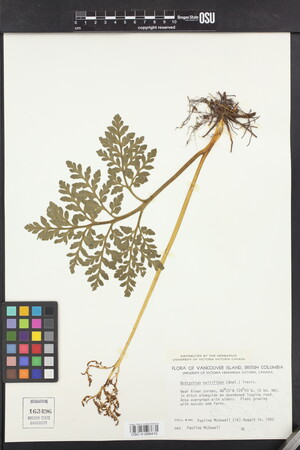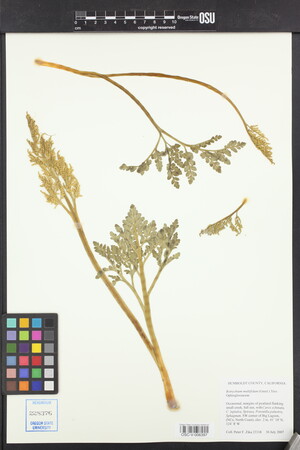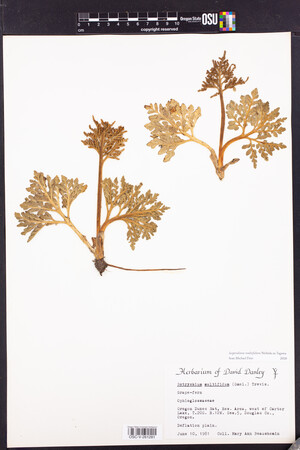Sceptridium multifidum
|
Sceptridium multifidum Nishida ex Tagawa
 (redirected from: Botrychium multifidum subsp. silaifolium (K. Presl) Clausen) (redirected from: Botrychium multifidum subsp. silaifolium (K. Presl) Clausen) |
|
|
Family: Ophioglossaceae
Leathery Grape Fern, more...broadleaf grapefern, leathery grapefern, Sila Grape Fern
[Botrychium californicum Underwood, moreBotrychium coulteri Underwood, Botrychium matricariae (Schrank) Spreng., Botrychium multifidum (Gmel.) Trev., Botrychium multifidum subsp. californicum (Underwood) Clausen, Botrychium multifidum subsp. coulteri (Underwood) Clausen, Botrychium multifidum subsp. silaifolium (K. Presl) Clausen, Botrychium multifidum var. californicum (Underwood) Broun, Botrychium multifidum var. coulteri (Underwood) Broun, Botrychium multifidum var. intermedium (D.C. Eat.) Farw., Botrychium multifidum var. multifidum , Botrychium multifidum var. silaifolium (K. Presl) Broun, Botrychium obliquum var. habereri Gilbert, Botrychium occidentale Underw., Botrychium rutifolium A. Braun, Botrychium silaifolium K. Presl, Botrychium silaifolium var. californicum (Underw.) Jeps., Botrychium silaifolium var. coulteri (Underwood) Jepson, Sceptridium silaifolium (C. Presl) Lyon] |
Trophophore stalk 2--15 cm, 0.3--1.2 times length of trophophore rachis; blade shiny green, plane, ternate, 2--3-pinnate, to 25 × 35 cm, leathery. Pinnae to 10 pairs, approximate to remote, horizontal to ascending, distance between 1st and 2d pinnae not or slightly more than between 2d and 3d pairs, divided to tip. Pinnules obliquely ovate, rounded, margins usually ± entire to shallowly crenulate, sometimes inconspicuously and shallowly denticulate, apex rounded, venation pinnate. Sporophores 2--3-pinnate, 1.2 times length of trophophore. 2 n =90. Leaves green over winter, appearing in spring. Widespread mainly in fields; 0--3000 m; Greenland; Alta., B.C., Man., N.B., Nfld., N.W.T., N.S., Ont., Que., Sask.; Alaska, Ariz., Calif., Colo., Conn., Idaho, Ill., Ind., Iowa, Maine, Mass., Mich., Minn., Mont., Nev., N.H., N.J., N.Y., N.Dak., Ohio, Oreg., Pa., R.I., S.Dak., Utah, Vt., Va., Wash., W.Va., Wis., Wyo.; Europe; nw Asia. Botrychium multifidum is rather similar to B . robustum (Ruprecht) L.Underwood of Japan, eastern China, and the former Soviet republics. Specimens identified as B . robustum have been collected on Unalaska Island.
Perennial fern 10 - 45 cm tall Stem: single, upright, very short and inconspicuous, up to 5 mm in diameter with a thickened base (caudex). Spores: thousands per sac, all of one kind, three-sectioned (trilete), thick-walled, and with a bumpy or pimply surface. The spores give rise to the gametophyte (the sexual phase of the plant), which is broadly egg-shaped, unbranched, tiny (1 - 3 mm tall, 1 - 10 mm diameter), fleshy, not green, underground, saprophytic, and inhabited by symbiotic fungi (mycorrhizae). Leaf: one per stem, on stalk arising from an expanded, clasping base, which forms a closed sheath around stem apex. The single leaf is made up of two parts arising from a shared stalk: a sterile, green, expanded blade portion (trophophore); and a fertile, stalk-like, spore-bearing portion (sporophore). Leaves appear in spring and usually remain green even over winter. Roots: up to ten per plant, blackish, 1 - 4 mm in diameter, and originating 1 cm below the base of the plant. Similar species: Botrychium multifidum is most similar to B. rugulosum, but that species has very wrinkled final divisions on the sterile blade (trophophore), which are also pointed at the tip and covered with pointed teeth. Also similar are B. oneidense and B. dissectum, but in both of those species the trophophore has the terminal pinnules distinctly larger than the lateral pinnules. Further B. oneidense tends to have dull bluish green trophophores, and often the pinnules of B. dissectum are narrow with finely cut edges, thus the trophophore appears finely dissected. Possibly somewhat similar is B. virginianum, but that species has the sterile portion of the leaf (trophophore) stalkless at the the base of the fertile portion (sporophore), which is at least midway up the shared main stalk. Our other species have trophophore blades that are distinctly longer than wide. Habitat and ecology: Incredibly rare, in woods. Occurence in the Chicago region: native Notes: This species is incredibly rare in Illinois and is probably extinct in Indiana. The Chicago Region is at the very south end of the range of this species in the Midwestern United States. Author: The Field Museum Plants 10-45 cm; bud pilose, its blade and sporophore reflexed; blade inframedial or nearly basal on an evident stalk, evergreen, rather fleshy or coriaceous, sparingly pilose, 3-15 נ3-20 cm, plane in life, 2-4 times ternate-pinnately compound, the pinnae and lesser segments often crowded, the ultimate segments less than twice as long as wide, obtuse or rounded, subentire to crenate or dentate; sporophore long-stalked, bipinnate or tripinnate; 2n=90. Meadows and open woods; circumboreal, in Amer. s. to N.C., Ill., Io., and Calif. Mostly Aug.-Sept. (B. matricariae; B. silaifolium) Gleason, Henry A. & Cronquist, Arthur J. 1991. Manual of vascular plants of northeastern United States and adjacent Canada. lxxv + 910 pp. ©The New York Botanical Garden. All rights reserved. Used by permission. From Flora of Indiana (1940) by Charles C. Deam This report is based upon specimens collected by Marcus Lyon, Jr., and R. M. Tryon, Jr., in the Dunes State Park, Porter County. Tryon reported his specimens as Botrychium dissectum f. elongatum. R. T. Clausen and E. T. Wherry have seen these specimens and refer them to this species. |




















































































